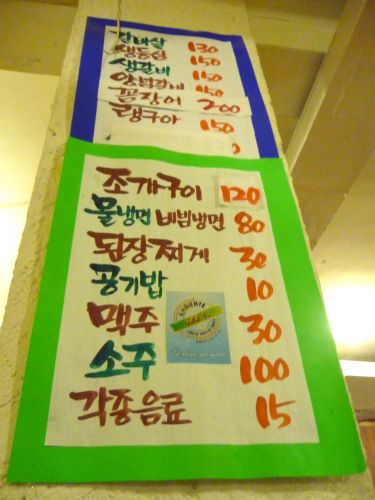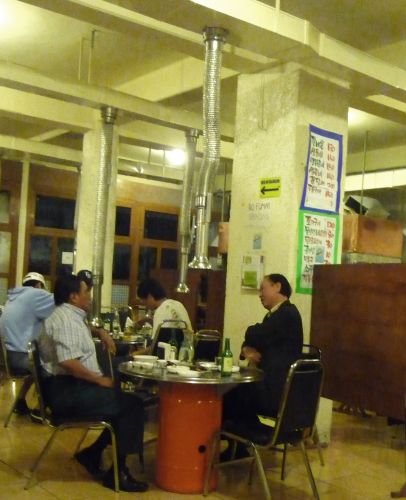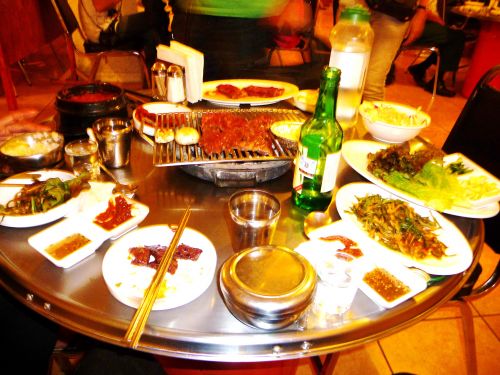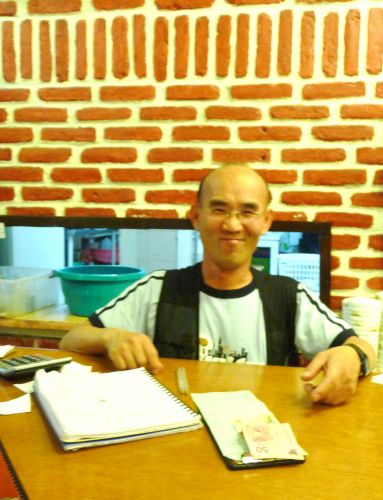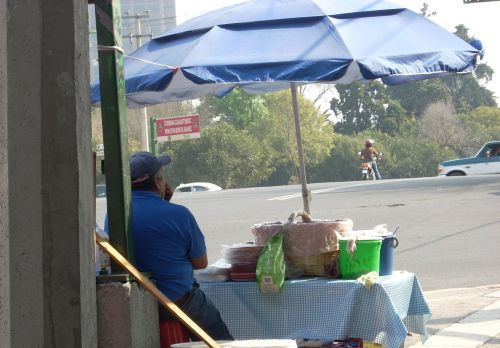It's been around since 1954, and Café La Habana, at the corner of Bucareli and Morelos in Colonia Juárez, has become the stuff of legend. Once, the offices of all the Mexican newspapers were around the corner, and Café La Habana was their reporters' favorite haunt. It was also popular among writers -- Salvador Novo, Juan Rulfo, Augusto Monterroso and Juan Jose Arreola are all said to have gotten into heated discussions or worked at the tables here. It is more or less a character in the work of Roberto Bolaño, appearing in Los detectives salvajes and at least one of his short stories. Fidel Castro and Che Guevara are said to have planned the Cuban revolution here. If truth be told, the food is at best adequate, and the service is, to put it mildly, unhurried. Still, the coffee is excellent, and it is a wonderful place to watch people -- both the clientele and those who pass by outside the picture windows.
Mexico City food
Struttin' with some barbecue
When people ask me what I miss about the United States, I instantly say "my friends." After that it often takes me a while to come up with anything else. The truth is that there are certain foods I crave that you cannot find in Mexico City. Among them is barbecue. I am talking about the kind you get south of the Mason Dixon line.
Luckily, the Dixie variety is not the only barbecue in the world. Here in Mexico City there is a significant Korean community, mostly made up of importers and exporters. Although they are not large in numbers, they are very visible, principally due to their restaurants and grocery stores on the fringes of the Zona Rosa.
Last week I had some kickass Korean barbecue at Nadefo, on Calle Liverpool #183, near the corner of Florencia. I have never been to Korea but it was as good as any I've had in Korean restaurants in New York. My dining companion, a Korean American, liked it so much that she wanted to return the following night.
There is a small menu, including an outstanding spicy vegetable and tofu soup, and a couple of noodle dishes. Mostly you go to Nadefo for meats that are grilled over burning charcoals. If you don't know what you are getting into, the waiters -- or Mr. Kim, one of the owners -- will explain.
Bucket shop
For the past 28 years, each weekday afternoon, Julián Sánchez, a portly man in his late 40s with salt-and-pepper hair and a moustache, exhorts passersby to buy food from buckets he has set up at a little table on the corner of Calle Dakota and Calle Yosemite in the Colonia Nápoles. “Come on, boss, what are you having?” he’ll say as he doles out meals. “Aren’t you hungry?”
He hardly needs to shout. At lunch hour there is almost always a cluster of a dozen or more people either eating or lined up to buy the food, which has been prepared by Julián’s wife Rosita. With a stoic expression, she collects the money, her hand covered in a plastic glove. Her severe visage may be due to the fact that she awakens every day at 4 a.m. to prepare the victuals, while Julián refers to his role in the operation as “the orchestra conductor.” (Rosita was ill the day I took this picture. Their daughter Elizabeth assisted.)
There are various elegant restaurants in the Colonia Nápoles, but Rosita’s is hands down the best inexpensively-priced food in the neighborhood. Each day she and Julián offer variety as well as quality – they may have pipián de puerco (a pork stew in a mild chile sauce) with nopal cactus; chicken in green mole; meatballs in chipotle, and breaded chicken cutlets in green sauce. These dishes are sold as fillings for tacos, or on Styrofoam plates with rice and beans. “We don’t have a set menu for every day in the week,” says Julián. “We keep changing it up so the people don’t eat the same things every day.”
Sweaty tacos
It is the dream of every unskilled Mexican with no connections to establish a business selling food. Particularly profitable are stands on the street, because they require minimal investment and their owners are duty-bound to pay few taxes. Some don’t pay any at all.
The least adorned points of sale are those which dispense tacos sudados – sweaty tacos, so-called because after being fried in the morning, they sit steaming in a basket during the day until their vendors sell out. (They are also known as tacos de canasta, or tacos in a basket.) Most commonly stuffed with potatoes, beans, fried pork rinds or green mole, they are delicious and extremely cheap – usually 3.5 pesos, or about 23 cents U.S. at the current exchange rate.
Juan Monsalvo, the fellow who from whom I most commonly buy tacos sudados, reeks of humility. Missing a couple of front teeth, he is impeccably well-mannered and always speaks to his customers using the polite form of address. I once asked him how many tacos he sells a day. He said that on a good day he will sell out his ration of 250. At 3.50 pesos each, that represents gross earnings of over $50 US.
But then he told me that he gets up at four o’clock each morning and makes 2000 tacos. A phalanx of salesmen buy the rest from him at a peso each and vend them on their own streetcorners. His workday lasts twelve hours. Math is not my strong point, but I believe he makes more money than I do.
Amanda
She was by far my laziest student. She had long eyelashes; lank, dark hair, and a huge, slack and provocative mouth. These qualities, combined with the fact that she only stood about four feet tall, gave her the look of a sexually precocious, perverse baby.
She took workshops in creative writing with me at the Escuela Dinámica de Escritores. Yet when the day came to hand in assignments, most of the time, she wouldn’t bother to show up. Once, she gave me her homework, and it was all of one sentence. “This is fine, Amanda,” I said, trying to encourage her. “But it would be nice to see the sentence that comes after, and the one that comes after that.” Her response was nothing more than an insolent look, as if I were truly clueless.
A year or two after classes were over, she resurfaced as “Amandititita,” something of a novelty act in the Mexico City pop music firmament. She has cut a couple of CDs and been covered widely by the press. Not long ago I read an interview in which she complained about how many commitments she has – as a pop sensation, her time is no longer her own. Click here to see a video of her biggest hit, in which she sings about the travails of having a metrosexual boyfriend.

